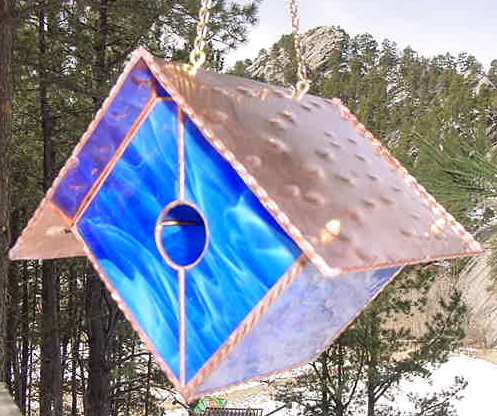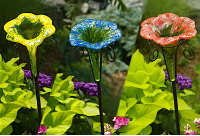-
Unique Birdhouses Relieve Real Estate Chrunch
With the sketchy economy, the real estate market suffers too. Imagine then, for a moment, being a nesting, or cavity dwelling bird and looking for a home? Their real estate market is scary too!
Many birds will nest in cavities – holes found in trees and fence posts. Some can chisel and craft their own homes, like woodpeckers, but most must find suitable diggs to nest and raise their young. Sadly, these nest boxes are very far and few between.
Even with unique birdhouses, you’ll help alleviate this problem, as more than fifty species of birds will use nest boxes or birdhouses.
Totally fun, yet functional housing for your feathered friends to raise a brood or two! High quality, unique birdhouses make wonderful and long-lasting gifts for nature enthusiasts, plus you know they’ll actually be used and enjoyed for years.
For your own yard, these birdhouses brighten up any environment, and still provide a valuable home for wild birds. A better bird-watching experience awaits as the sites of parents and yound in the yard never cease to entertain and amaze! With a fresh water source or birdbath, you’re well on the way to creating a bird-friendly oasis. A feeder or two, housing, water, and no pesticides or chemicals and you’ve got it…Happy Birding!
- Bats & Butterflies, Bird Accessories, Butterfly Feeder, Misters and Birdbath Drippers, Uncategorized
Butterfly Feeders & Other Enticements
Entice butterflies to your yard with butterfly feeders and these simple tricks:
Butterfly feeders, either nectar or fruit can crafted pretty simply with household items. Over-ripe fruit (like bananas, melons or oranges) may be placed on a saucer and set on a tree trunk or stake. They’ll attract fruit flies, which butterflies consume for protein too. To hang butterfly feeders, use sisal rope or twine with a grapevine wreath for the base. The secret is sunny locations as butterflies love warm sun. If using nectar in a shallow bowl, add a sponge (a new one) to absorb the liquid as butterflies will consume the nectar in this fashion. Also, no need to purchase nectar, it’s the same solution used for hummingbirds. 1 Part sugar to 4 parts water. Never use anything but plain table sugar. Boiling is not necessary, but helps to dissolve the sugar more efficiently.
Water is another attractant, but butterflies won’t drink from an open source. Leaf misters are great, as they leave tiny puddles around where the mist falls. Butterflies will flit in and out of the gentle spray.
Using a waterless pond will attract the flying flowers too. Simply gather heat-absorbing rocks and place them on their side in a sunny location. Design a small circle, square, or free-form with rocks close together, an inch or two deep. Add sand and salts and keep moist to further attract butterflies. Line the area with plastic to keep the salts from seeping into your soil.
When placing feeders, misters, or rock baths, it’s best to have them in, or in close proximity to your butterfly garden. Use host plants and nectar plants for best results.
-
SUPPORTING GLOBAL re-LEAF
A Greener Footprint for the Global Leader of Green Racing
In an effort to support environmental efforts globally, the American Le Mans Series will join forces with AMERICAN FORESTS to support its “dollar-a-tree” Global ReLeaf program.
Throughout the 2010 season, Series teams, manufacturers, corporate partners and fans will have multiple ways to learn about the Series’ green racing initiatives and contribute to the program.
In support of AMERICAN FORESTS’ goal to plant 100 million trees by 2020, the Series pledges to plant more than 5,000 trees in 2010 to restore ecosystems that have been damaged by fire, disease, other natural disasters and overdevelopment.
This global outreach initiative acts in conjunction with the Series’ progressive “green” leadership on-track – namely through the U.S. Environmental Protection Agency, U.S. Department of Energy and SAE International-supported MICHELIN® GREEN X® Challenge, a season-long competition that measures each race car’s efficiency and greenhouse gas emission levels during competition.
“Since its inception, the American Le Mans Series has been at the forefront of developing green initiatives and solutions in motorsports,” said American Le Man Series President and CEO Scott Atherton.
“We are very proud of our efforts with the Environmental Protection Agency and Department of Energy as they relate to our on-track efforts. Our involvement with American Forests enables us to contribute to similar solutions away from the race track and is another way the American Le Mans Series can advocate for a greener tomorrow.”
With the implementation of the Green ReLeaf campaign, the Series will begin every race weekend by displaying a Survivor tree in the paddock. The Survivor Elm – donated by the Series and its teams through AMERICAN FORESTS’ Historic Tree program – will encourage fans to do their part for the planet in a number of ways:
• Purchase the Series “To a Greener Tomorrow. Faster” organic t-shirt or its 2010 Spotters Guide Poster, where all proceeds go to AMERICAN FORESTS’ Global ReLeaf
• Donate – on-line and at the track – to win a chance for a hot lap around the track, on behalf of the Series’ Vitesse Program
• Donate a dollar to plant a tree at-track and online at americanlemans.comFor every three trees planted, roughly one ton of carbon will be sequestered, allowing for over 1,666 tons of CO2 to be taken out of the atmosphere overall, and every acre of trees planted (approx. 340-490 trees) by the Series will offset about the amount of CO2 produced by driving a car 26,000 miles, or about twice the amount the average driver drives per year.
“American Forests is pleased to partner with the American Le Mans Series to underscore the positive steps they’re making in the development of green initiatives,” said Gerry Gray, acting executive director of AMERICAN FORESTS. “Through their contribution goal of 5,000 trees, and their display of the Historic Survivor Tree – an important symbol of human resilience, and a tribute to renewal and rebirth – the Series is helping to create a cleaner environment for future generations.”
AMERICAN FORESTS is the nation’s oldest nonprofit conservation group, dedicated to growing a healthier world with trees. Our work encompasses planting trees for ecosystem restoration through our Global ReLeaf program, calculating the value of urban forests, fostering environmental education, and improving public policy for trees. AMERICAN FORESTS also maintains the official listing of the largest-known trees of their species in the United States. We have a goal to plant 100 million trees to restore damaged ecosystems in the U.S. and around the world by 2020.
AMERICAN FORESTS’ Historic Tree program (historictrees.org) brings history alive by propagating and selling the offspring of trees connected to significant historical people, places and events, offering a unique way for people to connect to the past while being part of a sustainable future. The Historic Tree program helps people understand how trees benefit us all – environmentally, socially, and economically.
The original Survivor Tree in downtown Oklahoma City bore witness to one of the nation’s most notorious terrorist attacks. Today a plaque around the tree reads, “The spirit of this city and this nation will not be defeated; our deeply rooted faith sustains us.”
The American Le Mans Series, based on the prestigious 24 Hours of Le Mans, is the only motorsports body in the world that features multiple street-legal alternative energy sources – clean diesel, E10 and E85 cellulosic ethanols, and new hybrid technologies. The American Le Mans Series has taken a leadership role in motorsports for the furthering of alternative fuel technology and use. It also illustrates deeper the Series’ relevance to its list of prestigious manufacturers and affluent customer base.
The American Le Mans Series will open its 12th season with America’s greatest sports car race, the 58th Mobil 1 Twelve Hours of Sebring presented by Fresh from Florida from March 17-20. The green flag will fall at 10:35 a.m. on Saturday, March 20 with live coverage on SPEED. Visit the American Le Mans Series’ schedule page for ticket and accommodation information. The annual American Le Mans Series Winter Test is scheduled for February 22-23, also at Sebring International Raceway. American Le Mans Series cars will be on track from 8 a.m. to noon and 1 to 5 p.m. both days. Tickets are $10 per day with no public paddock access or overnight camping. Live Timing & Scoring will be available on americanlemans.com..
You can follow the Series on Twitter (almsnotes) and the Series’ Facebook page and official YouTube channel.



